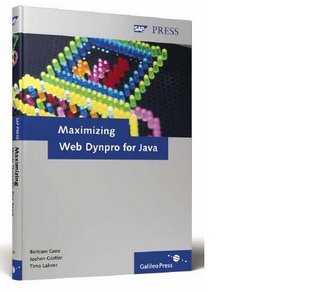Tuesday, December 26, 2006
Dclick Ads (Sponsored Link)
Wednesday, December 20, 2006
What is mySAP CRM?
Here are some business scenarios that CRM will cover, for instance:
- Marketing Management – i.e. campaign management, customer profitability analysis, digital asset management, scenario planning, survey analytics and etc.
- Sales Management – i.e. sales planning, account and contact management, lead and opportunity management, quotation and order management, contract management, incentive and commission management and etc.
- Interaction Center – it has Interaction Center for marketing, sales, sales order, management and services
- E-commerce – covers e-marketing, e-selling and –service
- Channel Management – account and contract management, campaign management with channel partner, lead and opportunity with channel partner, collaborative selling, partner management, quotation and order management for business-on-behalf.
You can refer to this link for more functional and technical documentation: http://help.sap.com/saphelp_crm50/helpdata/en/0d/02cc3e1cc6304fe10000000a114084/frameset.htm

Labels: SAP
Sunday, December 17, 2006
Book: Maximazing Web Dynpro for Java
This book has it all - everything you need to know in order to get the very most from your Web Dynpro applications - straight from the developers at SAP.
Based on interesting (and surprising) sample applications, such as GameStation, Google Search, and MusicBox, this unique reference helps you easily memorize the vast array of Web Dynpro for Java capabilities in an engaging and entertaining manner.
Readers learn about the dynamic creation of UI components and how to access web services and get details on the integration of Web Dynpro applications into SAP NetWeaver Portal, the componentization of applications, navigation options between different Web Dynpro applications, display techniques, and much more. An entire chapter is devoted to the installation, configuration, and administration of the Web Dynpro runtime. In addition, this comprehensive book provides you with many tips and tricks to increase the speed, security, and structure of your Web Dynpro applications, as well as key insights on troubleshooting and performance optimization.

You can order this book in SAP Press or Amazon.com
Labels: Java, SAP, SAP Books, Web Dyndro Java
Friday, December 15, 2006
Introduction to SAP Employee Self Services
What is it about? ESS implementation help to let employees responsible for maintaining their own personal information such as personal profile, vacations, sick leave, training and etc. In the past time, an employee used to make phone calls or filing up paper forms in HR Department to perform their personal information maintenance. But now, through the deployment of SAP ESS, it provides a simplified channel for the employee to access and maintain their personal information through web browser anywhere they like.
In SAP, there are two options for implementing ESS. You can implement through SAP Enterprise Portal or use a standalone solution with transaction PZM3 in SAP R/3. If a company had some investment on SAP portal technology for other functionalities, it is strongly recommended to implement the ESS through portal as it provides more unified platform for managers and employees that perform other tasks through portal.
So, what functionality ESS provide? Here is a summary list:
● Benefits and Payment
● Working Time
● Career and Job
● Employee Search
● Personal Data
● Travel Management
● Corporate Information
● Life and Work Events
You can also visit to this link for more information:
ESS in Personnel Administration
http://help.sap.com/saphelp_erp2005vp/helpdata/en/c5/0fab358b096510e10000009b38f839/frameset.htm
Business Package for Employee Self Services
http://help.sap.com/saphelp_erp2005vp/helpdata/en/c4/4f5a41a8f17743b15e15ebdeaa0c5d/frameset.htm
This is how ESS looks like in the portal.

Labels: SAP
Wednesday, December 06, 2006
How and Where to Use the Tag Library?
You can use any navigation tag like you use other JSP tags in your JSP pages. As usual, you create a portal components in a PAR file that contains all the JSP pages and a portalapp.xml file.
1) As you refer other tag library (i.e. htmlb, make sure you add the following tag library reference at the top of your JSP page:
<%@ taglib uri="NavigationTagLibrary" prefix="nav" %>
2) Go to the portalapp.xml file, add the following:
<property name="SharingReference" value="com.sap.portal.navigation.navigationtaglibrary"/>
as a sharing reference in "application-config".
and
as a shring reference in "component-profile".
Labels: Portal
Sunday, December 03, 2006
Navigation Tag Library
SAP provided portal developers a navigation tag library to make their job easy in developing navigation iviews based on JSP pages.
1) Navigation Iterator
- Iterates through a set of nodes, exposing in its body a different navigation node during each iteration.
2) Navigation Node
- Exposes specific navigation node, select the current node and its parent node to execute the body tag.
3) Operator
- Performs operations like storing or recall a navigation node.
4) Rendering
- display HTML (can e any form of interface compomnent) based on the currently exposed navigation node.
5) Conditional
- Check true or false condition to determine whether to include its tag body.
Labels: Portal
